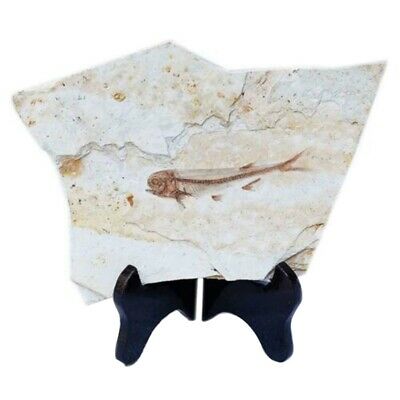-40%
Ultra RARE Juvenile Fossil Cyclurus Bowfin Fish Fossil Lake Wyoming COA 2299
$ 630.95
- Description
- Size Guide
Description
A Certificate of Authenticity will accompany this order.For your consideration is an example of an extraordinarily rare item, from the world-famous fossil beds of Fossil Lake, Green River Formation, Wyoming. From the Eocene, 52 million years ago.
It is a fossil juvenile Cyclurus Gurley, also referred to as a Bowfin. Cyclurus is an extremely rare fish in Fossil Lake, and a juvenile is next to unique, rarer than the very rare adult fossil Cyclurus. Order Amiiformes, Family Amiidae.
Here is how extremely rare it is: In the book, The Lost World of Fossil Lake (2013), Lance Grande of the University of Chicago gives a masterful history and description of ancient Fossil Lake life. On pages 176-77, each fish is listed in order of their abundance being found as fossils. Cyclurus is one of the rarest of all fish, with an estimated total of 20+ since 1870 being found. In addition, here are his comments about the Cyclurus Bowfin "Rarer than the other amiid, Amia Pettersoni; juveniles are extremely rare." So out of a total of about 20 Cyclurus Bowfin found all-time, those of that 20 that are juveniles are extremely rare. So I am guessing maybe one or two juveniles have been found all-time. I searched through the internet and found exactly 1 (in Lance Grande's book).
Like the Notogoneus, where juveniles are very rare compared to adults, the young Cyclurus Bowfin probably grew up in tributaries, then entering the lake upon adulthood.
This specimen is about 3.6" (9.2 cm.) in length. The plate is about 2.8" by 4.7", and it weighs 8.55 oz. (245 grams).
To determine whether it is a Cyclurus or an Amia (the other, also extremely rare Bowfin from Fossil Lake), I looked at a number of factors.
I also looked at the single young juvenile Cyclurus and juvenile Amia in Grande's book, pages 119-123. This specimen for sale has some sharp teeth, as well as some molariform teeth (see photos). Molar-like teeth would be used in cracking shells, etc. in snails and gastropods. Amia only have sharp teeth, so that indicates this is a Cyclurus.
Also, Cyclurus have on average, 36 to 39 dorsal fin rays. Amia have 45-47. I counted the ones on this fish and I counted 33 dorsal fin rays. A little low for a Cyclurus, maybe a few more grow before maturity, or maybe a couple came off, but certainly a Cyclurus and not an Amia.
This fish appears to have had its caudal (tail) fin and other fin rays bitten off by predators, not by disarticulation. If you examine the close-up photos of the extreme posterior end of the Cyclurus, you can see a number of rays that appear strong. No disarticulation. Then those strong rays are suddenly gone, all at the same point, typical of a bite. In addition, if the rays were missing due to part of the plate chipping off, you should see the plate chip marks, with the matrix just beyond the visible rays being significantly lower than the matrix with the rays. But the plate looks fairly undisturbed. Which leaves us with predator bites. In fact, I would guess this Cyclurus juvenile suffered a number of vicious bites to its posterior, likely the cause of its demise.
All in all, a very appealing little Cyclurus specimen. Extraordinary rarity, nearly unique, for your collection or museum.
2299.KHF#YDRXIYGXJ



















